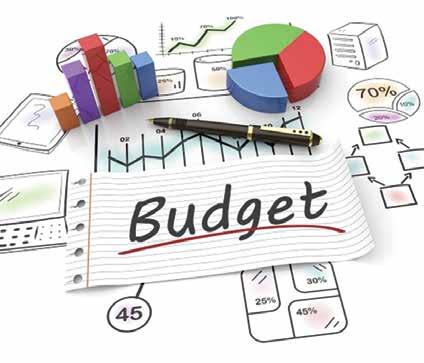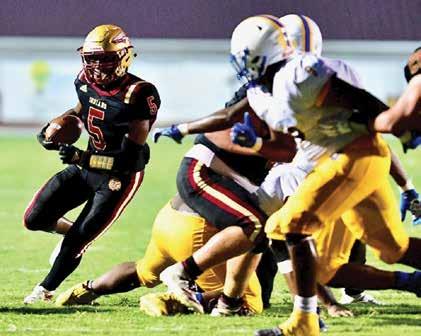
4 minute read
Chronicles Of Charles
The Budget Cure
by Charles Joseph
Advertisement
The average U.S. savings account contains $16,420. That’s $1,580 less than the average American spends on nonessentials alone each year. It’s a given that having savings is important. But con sider the average credit card debt per resident at $5,331 with only 55% paying it back in full each month. Making minimum payments at an APR (an nual percentage rate) of 15.09% it would take 44 months (or 3.7 years) to pay back. This includes interest paid of $1,620. Pretty bleak, right? There is good news, how ever. There are strategies within each consumer’s control to overcome the darkness. Like making the mortgage payment bi weekly instead of monthly. This saves an average of 30% on the interest and takes up to eight years off one’s mortgage. At its core, there is one funda mental element that influences these factors: budget. So, how does a budget work? First, the expense category must be exam ined. What are the primary expenses that you can count on to come out each month? Examples include the mortgage, cell phone, internet, utilities, etc. These bills are your constant. Therefore, you know that, aside from food, gas, and other basic essentials, these expenses will be covered first. Making a budget is all about having priorities. With the right priorities within your expense cat - egory, much can be conquered. For one, there is a sense of safety. You know that no matter what hits the fan, these bills will be paid and you will have shelter over your head. Now let us move on to the secondary category within expenses: basic essentials. This category is where things become more subjective. Things to consider, as mentioned above, are food, gas, hy giene, etc. A good question here is how often do you eat out? Meaning, how often do you scrub the idea of cooking din ner at a cheaper price opting to pay that extra fee to eat out? Did you know that the average U.S. household spends up to $3,000 per year eating out per year? That is $250 per month! Aside from your physical health, what are the bene fits of eating out? The opportunity to socialize? Instant gratification? How important are these activi ties to you? Ask yourself: How does this expendi ture play into my sense of budgeting priorities? Re member, the idea is not to hole up and never spend money. The goal is to know where your expens es are going and to have a predetermined idea of how much you will allot to each expenditure while evaluating how important the expense is to you. Is it worth not adding to your savings? It has been recommended that a person or household have at least six months in savings to allow for emergencies, unexpected layoffs, or job difficulties (think pandemic) and the like. The median house hold (meaning the majority of people in the nation) makes $63,179 per year or $5,265 per month. Sounds manageable, right? But what happens to your treasured credit score that you worked years to build up if you cannot afford the pay ment because of an emergency? While it is true that some creditors allow a one-month forgiveness allowance from payment obligations, what hap pens after the payment hits the dreaded thirtyday overdue threshold? Your score lowers, which raises any potential inter est rates on future loans taken out for things such as cars or home improve ments. Now, you are not only in credit card debt at a painful interest rate, you have little savings, and getting a loan is almost if not completely out of the question! So, with this new infor mation, a budget sounds like a pretty good idea, right? Let’s recap. Below is a list of things to con sider when building the expense category of your new budget: 1. Create a sense of priority with each pur chase that you make.
Know beforehand how much you have allot ted to things like bills, groceries, and eating out. 2. Build a primary expense category that only includes bills that must come out each month no matter what. Pay these bills first if possible, and then consider the fol lowing: do you really need that extra televi sion channel package to survive? How often do you even use it? 3. Build a secondary expense category. This category takes a little more thought and con
sideration. Which things will you have to buy this month to keep you from going without? Gas to get to work, groceries for the house, and pet food are just some examples that may fit into this category for you. Now, remember to con gratulate yourself. You have conquered the dreaded budget. When you break the monster down into smaller pieces, it really is not that bad. And there is incredible safety and reward in knowing where your money is going. Adulting is not always fun, but let’s face it, dealing with the elephant in the room is better than ignoring it, or worse yet, running from it! In my next article, I will include a sample budget spreadsheet link when you visit our website www.athensnowal.com. I will also be continuing the conversation on budgeting. Once you have built your expense categories, come back to read about how to allocate savings and squeeze every last dime out of your budget.
Charles Joseph is an avid hiker, fisherman and kayaker having kayaked over a dozen rivers across the country. With a degree from Auburn University, he holds a background in account ing and banking. He is currently training as a fi nancial advisor. Feel free to email any questions or requests for future articles to c.joseph0613@ gmail.com.









